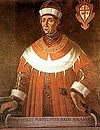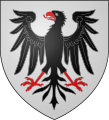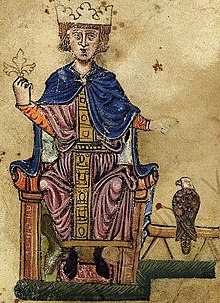Manfred (1232 â€" 26 February 1266) was the King of Sicily from 1258 to 1266. He was an illegitimate son of the emperor Frederick II of Hohenstaufen but his mother, Bianca Lancia (or Lanzia), is reported by Matthew Paris to have been married to the emperor while on her deathbed.
Background

Manfred was born in Venosa. Frederick II appears to have regarded him as legitimate, and by his will named him as Prince of Taranto and appointed him as the representative in Italy of his half-brother, the German king, Conrad IV. Manfred, who initially bore his mother's surname, studied in Paris and Bologna and shared with his father a love of poetry and science.
At Frederick's death, Manfred, although only about 18 years old, acted loyally and with vigour in the execution of his trust. The Kingdom was in turmoil, mainly due to riots spurred by Pope Innocent IV. Manfred was able to subdue numerous rebel cities, with the exception of Naples. When his legitimate brother Conrad IV appeared in southern Italy in 1252, disembarking at Siponto, his authority was quickly and generally acknowledged. Naples fell in October 1253 into the hands of Conrad. The latter, in the meantime, had grown distrustful of Manfred, stripping him of all his fiefs and reducing his authority to the principality of Taranto.
In May 1254 Conrad died of malaria. Manfred, after refusing to surrender Sicily to Innocent IV, accepted the regency on behalf of Conradin, the infant son of Conrad. The pope however, having been named guardian of Conradin, excommunicated Manfred in July 1254. The regent decided to open negotiations with Innocent. By a treaty made in September 1254, Apulia passed under the authority of the pope, who was personally conducted by Manfred into his new possession. But Manfred’s suspicions being aroused by the demeanour of the papal retinue, and also annoyed by the occupation of Campania by papal troops, he fled to the Saracens at Lucera. Aided by Saracen allies, he defeated the papal army at Foggia on 2 December 1254, and soon established his authority over Sicily and the Sicilian possessions on the mainland. In that year Manfred supported the Ghibelline communes in Tuscany, in particular Siena, to which he provided a corps of German knights that was later instrumental in the defeat of Florence at the Battle of Montaperti. He thus reached the status of patron of the Ghibelline League. Also in that year Innocent died, succeeded by Alexander IV, who immediately excommunicated Manfred. In 1257, however, Manfred crushed the papal army and settled all the rebellions, imposing his firm rule of southern Italy and receiving the title of vicar from Conradin.
Kingship

The following year, taking advantage of a rumour that Conradin was dead, he was crowned King of Sicily at Palermo on August 10. The falsehood of this report was soon manifest; but the new king, supported by the popular voice, declined to abdicate and pointed out to Conradin’s envoys the necessity for a strong native ruler. The pope, to whom the Saracen alliance was a serious offence, declared Manfred’s coronation void. Undeterred by the excommunication Manfred sought to obtain power in central and northern Italy, where the Ghibelline leader Ezzelino III da Romano had disappeared. He named vicars in Tuscany, Spoleto, Marche, Romagna and Lombardy. After Montaperti he was recognized as protector of Tuscany by the citizens of Florence, who did homage to his representative, and he was chosen "Senator of the Romans" by a faction in the city. His power was also augmented by the marriage of his daughter Constance in 1262 to Peter III of Aragon.
Terrified by these proceedings, the new Pope Urban IV excommunicated him. The pope first tried to sell the Kingdom of Sicily to Richard of Cornwall and his son, but in vain. In 1263 he was most successful with Charles, the Count of Anjou, a brother of the French King Louis IX, who accepted the investiture of the kingdom of Sicily at his hands. Hearing of the approach of Charles, Manfred issued a manifesto to the Romans, in which he not only defended his rule over Italy but even claimed the imperial crown.
Charles' army, some 30,000 strong, entered Italy from the Col de Tende in late 1265. He soon reduced numerous Ghibelline strongholds in northern Italy and was crowned in Rome in January 1266, the pope being absent. On 20 January he set southwards and waded the Liri river, invading the Kingdom of Sicily. After some minor clashes, the rival armies met at the Battle of Benevento on 26 February 1266, and Manfred's army was defeated. The king himself, refusing to flee, rushed into the midst of his enemies and was killed. Over his body, which was buried on the battlefield, a huge heap of stones was placed, but afterwards with the consent of the pope the remains were unearthed, cast out of the papal territory, and interred on the bank of the Garigliano River, outside of the boundaries of Naples and the Papal States.
Manfred was married twice. His first wife was Beatrice, daughter of Amadeus IV, count of Savoy, by whom he had a daughter, Constance, who became the wife of King Peter III of Aragon; his second wife, who died in prison in 1271, was Helena Angelina Doukaina, daughter of Michael II Komnenos Doukas, ruler of the despotate of Epirus, who made this marriage to ally with Manfred after being attacked by him at Thessalonica. Helena and Manfred had five children: Beatrice, Frederick, Henry, Enzio and Flordelis of Sicily.
At the Battle of Benevento Charles captured Helena and imprisoned her. She lived five years later in captivity into the castle of Nocera Inferiore where she died in 1271. Manfred's son-in-law Peter III became also King Peter I of Sicily from 1282 after the Sicilian Vespers expelled the French from the island again.
The modern city of Manfredonia was built by King Manfred between 1256â€"1263, some kilometers north of the ruins of the ancient Sipontum. The Angevines, who had defeated Manfred and stripped him of the Kingdom of Sicily, christened it Sypontum Novellum ("New Sypontum"), but that name never imposed.
Character and legacy

Contemporaries praise the noble and magnanimous character of Manfred, who was renowned for his physical beauty and intellectual attainments. In the Divine Comedy, Dante meets Manfred outside the gates of Purgatory, where the spirit explains that, although he repented of his sins in articulo mortis, he must atone for his contumacy by waiting 30 years for each year he lived as an excommunicate, before being admitted to Purgatory proper.
Manfred forms the subject of dramas by E.B.S. Raupach, O. Marbach and F.W. Roggee. Three letters written by Manfred are published by J. B. Carusius in Bibliotheca historica regni Siciliae (Palermo, 1732).
Manfred's name was borrowed by the English author Horace Walpole for the main character of his short novel The Castle of Otranto (1764). Montague Summers, in his 1924 edition of this work, showed that some details of Manfred of Sicily's real history inspired the novelist. The name was re-borrowed by Lord Byron for his dramatic poem Manfred (1817).
Notes

References
- Momigliano, Eucardio (1963). Manfredi. Milan: Dell'Oglio.Â
-  This article incorporates text from a publication now in the public domain: Chisholm, Hugh, ed. (1911). Encyclopædia Britannica (11th ed.). Cambridge University Press.Â
External links

- Markus Brantl: Regesten und Itinerar König Manfreds von Sizilien, 2005 (XML-version, pdf-version, 6 MB)(German)
.jpg/280px-Altstetten_(cut).jpg)
